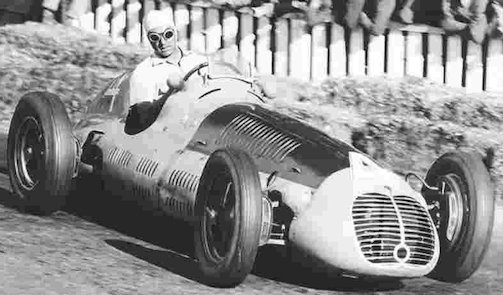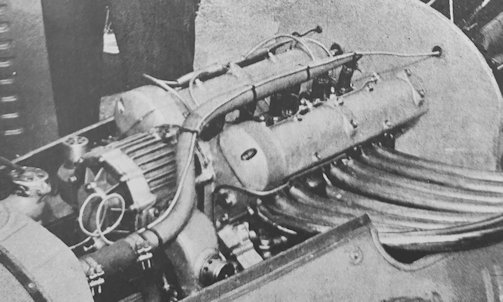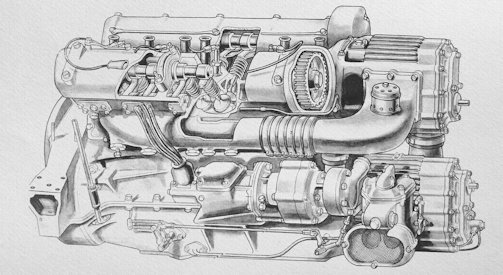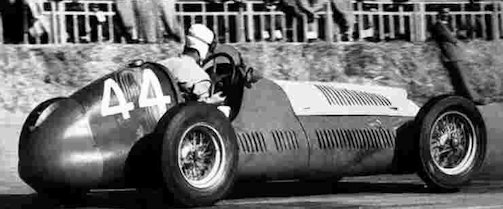Maserati 4CLT Grand Prix Car
 | |
Manufacturer | Maserati |
Class | Race Car |
Seats | Single |
Engine | 4-cylinders Capacity 1,496 to 2000c.c. |
Production | from 1947 to 1950 |
Length | 3850 mm |
Width | 1400 mm |
Height | 1000 mm |
The Maserati 4CLT, were single-seat competition race cars built by Maserati post war from 1947 to 1950.
History
Introduced in 1947. Basically as the Type 4CL but with a tubular chassis. Part of the tubular frame was used for the oil reservoir. Two of these cars with modified rear frame were used by Arlaldo Ruggeri and raced at various times by several drivers, including Bucci. Normal 4CLT models were driven in 1948 by Farina (winner at Geneva and Monte Carlo) and Villoresi.
In 1946 revived 4Cs were in the forefront of motor racing's reawakening, and the design quickly developed with two-stage super-charging and with a tubular chassis frame in place of the former girder type. These developed models were known first as the 4CL, then with the tubular chassis as the 4CLT At all times the independent front suspension had been by wishbones and torsion bars, with quarter-elliptic leaf springs carrying a rigid axle at the rear The project was by Ernesto Maserati, Alberto Massimino, Vittorio Bellentani and Arialdo Ruggieri.
In 1948 the 4CLT in its definitive form with coil-springs for the front suspension tucked in-board out of the airstream and operated by extension lever arms attached to the wheel-hub carriers. This 4CLT/48 model was raced by the quasi-works Scuderia Ambrosiana team and sold well to private entrants.
In their debut two 4CLT/48s were placed 1—2 at San Remo, driven by Alberto Ascari and Luigi Villoresi. The model was known as the San Remo Maserati ever after. Villoresi won four more major races that season, and was second to Vanille’s Alfa Romeo in the Italian Grand Prix, beating a new VI 2 Ferrari in the process. In the winter of 1948—49 4CLT/48s raced in the Argentine Temporada series, a virtual unknown named Juan Manuel Fangio scoring an early international success in one.
When Alfa Romeo withdrew for the 1949 season, Maserati briefly assumed their mantle before being overtaken by Ferrari's V12s. Fangio made his name in Europe with a 4CLT, while drivers like Reg Parnell, 'B. Bira' and Dr Farina all won for the trident. By 1950, however, the claimed 260 bhp of the 78mm x 78mm, 1490cc engine was achieved at the expense of oil-oozing unreliability. The old engine had reached the end of its development and although still competitive in club racing events the Maserati 'fours' were now non-entities at Grand Prix level.
The changes to the chassis and the engine operated on the 4CL led to the development of the 4CLT, where the " T " stood for t frame loom. The increase in torsional rigidity that the tubular structure was used to counterbalance the increase in torque and power, resulting from the use of two compressors applied to the old 4-cylinder in-line engine.
The power delivered by the engine was 260 bhp, against the 220 of the 4CL. Other changes were the use of a bearing for the crankshaft, components of the forged rear suspension rather than castings, and the chassis designed to work with hydraulic shock absorbers. The displacement was 1491 cm³, and the layout of the cylinders was four in line. The change was a four-speed manual.

4CLT / 48 Sanremo (1948)
The 1948 model, introduced for the San Remo Grand Prix when Ascari and Villoresi finished first and second respectively. The cars next appeared at Berne (Grand Prix de l'Europe), then at Rheims (French' G.P.), Albi G.P. (when a third car was driven by Leslie Brooke), Italian Grand Prix (five cars ran—Villoresi, Ascari, Parnell, Brooke, Cortese) and Silverstone (Villoresi and Ascari, first and second respectively). Villoresi and Parnell finished first and second at Barcelona. The Engine similar to 4CL but with different camshafts, con. rods, crankshaft bearings block, etc.Two-stage supercharging as in 4CL—blowers one above the ether driven off the front of the engine.
The first 4CLT variant derived its name from the name of the race where it debuted and won the first two places, more precisely at the 1948 Sanremo Grand Prix with Alberto Ascari and Luigi Villoresi. Villoresi and Reg Parnell then won five of the remaining races of the season. Other drivers who conquered important victories were Juan Manuel Fangio, Nino Farina and Prince Bira.
The main innovation was the use of a frame with circular section tubes with longitudinal and cross members, in place of profiled components. The innovation was applied with the aim of achieving a higher torsional rigidity that would have allowed a greater speed in the curve. The engine, with a displacement of 1490 cm³, finally adopted two dual-stage compressors with a Weber carburettor upstream of them, which allowed the engine to deliver 270 hp, brought to almost 330 by the studies of Professor Speluzzi of Scuderia Milano. The compression ratio was 6: 1 and the gearbox was four-speed plus reverse. The distribution was four valves per cylinder at 90 °. The brakes were drum hydraulically actuated. The suspensions were Houdaille hydraulic shock absorbers and stabilizer bar. The anterior ones were helical springs, while the rear ones with crossbow. The body was in aluminium. The maximum speed of the car was 260–270 km / h. The car remained competitive until 1950.
After the introduction of the modified 4CLT / 49 chassis the following year, with two of the remaining 4CLT / 48 Sanremo, the displacement was increased to 1720 cm³; were used in Formula Libre Temporada races in Buenos Aires. In the first year of Formula 1 (1950 season), the 4CLT / 48 Sanremo disputed the best Maserati Championship in this competition. The last variants of the 4CL that took part in the World Championship were a 4CLT / 48 modified by Arzani-Volpini, which however failed to qualify for the 1955 Italian Grand Prix A long-time affiliate of Maserati, Enrico Platé, recognized the non-competitiveness of the cars of the Casa del trident in Formula 1, and then converted the 4 CLT / 48 into the Maserati-Platé 4CLT; with the updated model, Platé decided to participate in Formula 2 races. However, this automotive series was for aspirated engines, and the first step was therefore to remove the two compressors. After this, to compensate for the loss of performance resulting from this elimination, the compression ratio was doubled and the displacement was raised to the limit for the category, more precisely 2 L. With the decrease in power caused by the revisiting of the engine, the weight was decreased, and the handling was increased by reducing the wheelbase.

4CLT / 49 (1949)
The car known as 4CLT / 49. The name of the car was not official, since the name given to it by Maserati was never known small changes to drum brakes and aerodynamic appendages to the cooling slits, together with small changes in the control panel and the repositioning of the oil sump, gave rise to. The Ascari, Villoresi, Parnell trio of drivers, joined by Juan Manuel Fangio and Toulo de Graffenried, won nine of fifteen races of the 1949 season, including the success of Graffenried at the British Grand Prix, the last before the advent of Formula 1. A copy of the 4CLT / 49 was modified by Maserati to be able to mount a more powerful engine, a V12 built by OSCA.
4CLT / 50 (1950)
In 1950 began the first World Formula 1 Championship organized by the FIA. In response to improvements to the Alfa Romeo 158, and to the already competitive Ferrari and Talbot, Maserati updated the 4CLT engine. A crankshaft consisting of multiple components, lightened and balanced connecting rods, a pair of more powerful compressors and improvements to the injection system brought the engine 's power to 280 bhp. This was assembled with the intention of reducing the weight by 10 kg. With these improvements the Maserati almost reached the performance of the Alfa Romeo. Although moderately competitive for short races, the changes made were too relevant for the car's design, which was now ten years old, so much so that in the Grand Prix it often retired due to engine failure. During the season, the victories came only in races not valid for the Formula 1 World Championship. Juan Manuel Fangio won at the Pau Grand Prix; same day Reg Parnell won the Richmond Trophy at the Goodwood Circuit, and David Hampshire won the Nottingham Trophy. Fangio also won in Formula 2 the Grand Prix Rampart to Angoulême, on a frame of 4CLT the engine of the A6 GCM. The Scuderia Milano modified 4CLT / 50 to participate in the Formula 1 World Championship in the 1950 season and in the 1951 season, but without success.
The latest victories in the races
Toulo de Graffenried won the Richmond Trophy and Nino Farina the Grand Prix of Paris in 1951, but with the transition to the Formula 2 rules from the Formula 1 World Championship, it proved that the old 4CLT chassis was too heavy and the engine had power lower than rivals. Despite being one of the biggest cars in the top-level competitions of the late thirties, the 4CL and the 4CLT quickly lost their bite when new competition cars, smaller and lighter, were born from various European workshops, which among other things were still affected by the effects of the recently ended War.

Rating
Technical
-
Maserati 4CLT Technical details and specifications (1947-1950)
ENGINE:
4-cyl. in line.
1947 1,492 c.c. 1948 increased to 1720 cm³
o.h.v.
Bore and stroke 78 X 78 mm
Two-stage supercharging Roots-type
Weber carburettor upstream by 1950 twin compressors, injection system
compression ratio 6: 1
four valves per cylinder at 90 °TRANSMISSION DRIVE LINE:
four-speed manual plus reverseChassis :
tubular, lower than 4CLT.frame with circular section tubes with longitudinal and cross membersSUSPENSION:
Independent front suspension by coil springs at 60 deg. and wishbones.
forged rear suspension.
Houdaille hydraulic shock absorbers
stabilizer bar
BODY :
aluminium
redesigned, better streamline
lower frontal area.
Forward-sloping bonnet.BRAKES:
drum hydraulically actuated.© Motor car History




